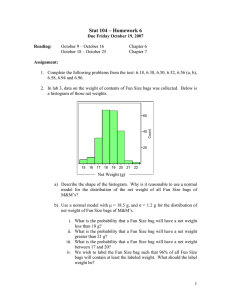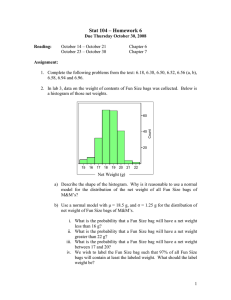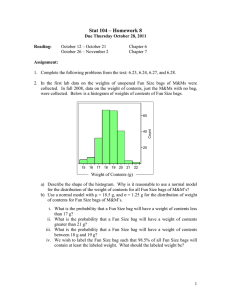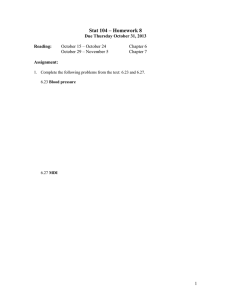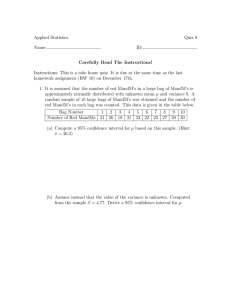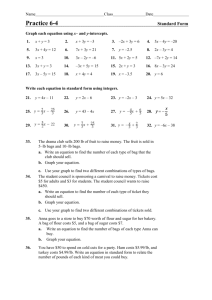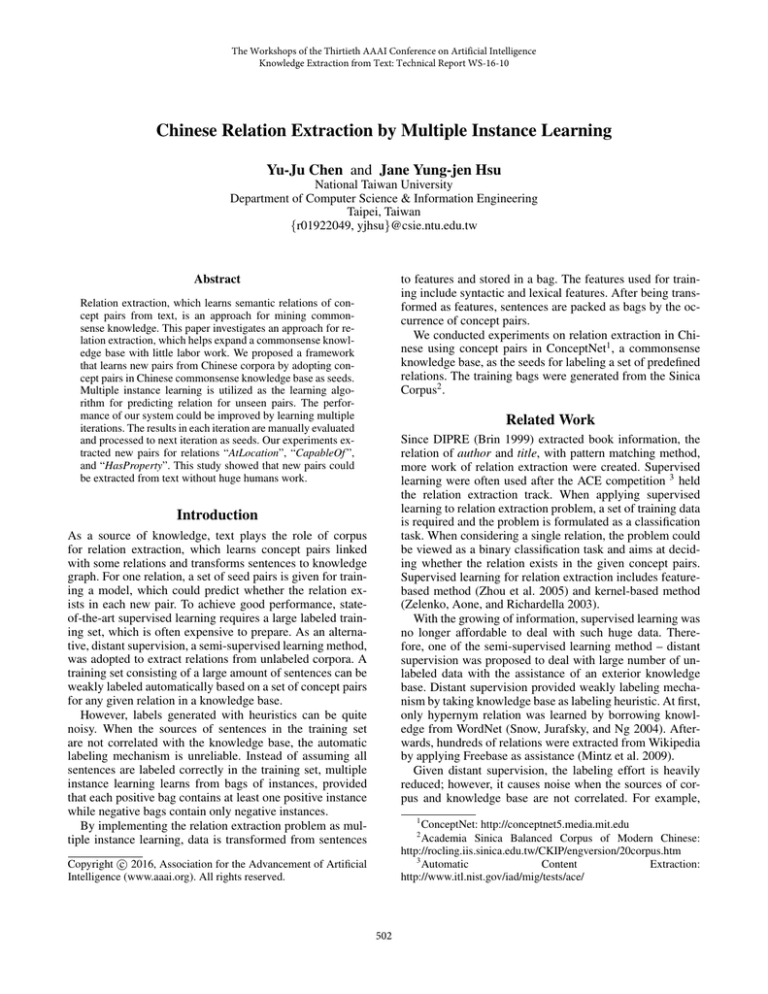
The Workshops of the Thirtieth AAAI Conference on Artificial Intelligence
Knowledge Extraction from Text: Technical Report WS-16-10
Chinese Relation Extraction by Multiple Instance Learning
Yu-Ju Chen and Jane Yung-jen Hsu
National Taiwan University
Department of Computer Science & Information Engineering
Taipei, Taiwan
{r01922049, yjhsu}@csie.ntu.edu.tw
Abstract
to features and stored in a bag. The features used for training include syntactic and lexical features. After being transformed as features, sentences are packed as bags by the occurrence of concept pairs.
We conducted experiments on relation extraction in Chinese using concept pairs in ConceptNet1 , a commonsense
knowledge base, as the seeds for labeling a set of predefined
relations. The training bags were generated from the Sinica
Corpus2 .
Relation extraction, which learns semantic relations of concept pairs from text, is an approach for mining commonsense knowledge. This paper investigates an approach for relation extraction, which helps expand a commonsense knowledge base with little labor work. We proposed a framework
that learns new pairs from Chinese corpora by adopting concept pairs in Chinese commonsense knowledge base as seeds.
Multiple instance learning is utilized as the learning algorithm for predicting relation for unseen pairs. The performance of our system could be improved by learning multiple
iterations. The results in each iteration are manually evaluated
and processed to next iteration as seeds. Our experiments extracted new pairs for relations “AtLocation”, “CapableOf ”,
and “HasProperty”. This study showed that new pairs could
be extracted from text without huge humans work.
Related Work
Since DIPRE (Brin 1999) extracted book information, the
relation of author and title, with pattern matching method,
more work of relation extraction were created. Supervised
learning were often used after the ACE competition 3 held
the relation extraction track. When applying supervised
learning to relation extraction problem, a set of training data
is required and the problem is formulated as a classification
task. When considering a single relation, the problem could
be viewed as a binary classification task and aims at deciding whether the relation exists in the given concept pairs.
Supervised learning for relation extraction includes featurebased method (Zhou et al. 2005) and kernel-based method
(Zelenko, Aone, and Richardella 2003).
With the growing of information, supervised learning was
no longer affordable to deal with such huge data. Therefore, one of the semi-supervised learning method – distant
supervision was proposed to deal with large number of unlabeled data with the assistance of an exterior knowledge
base. Distant supervision provided weakly labeling mechanism by taking knowledge base as labeling heuristic. At first,
only hypernym relation was learned by borrowing knowledge from WordNet (Snow, Jurafsky, and Ng 2004). Afterwards, hundreds of relations were extracted from Wikipedia
by applying Freebase as assistance (Mintz et al. 2009).
Given distant supervision, the labeling effort is heavily
reduced; however, it causes noise when the sources of corpus and knowledge base are not correlated. For example,
Introduction
As a source of knowledge, text plays the role of corpus
for relation extraction, which learns concept pairs linked
with some relations and transforms sentences to knowledge
graph. For one relation, a set of seed pairs is given for training a model, which could predict whether the relation exists in each new pair. To achieve good performance, stateof-the-art supervised learning requires a large labeled training set, which is often expensive to prepare. As an alternative, distant supervision, a semi-supervised learning method,
was adopted to extract relations from unlabeled corpora. A
training set consisting of a large amount of sentences can be
weakly labeled automatically based on a set of concept pairs
for any given relation in a knowledge base.
However, labels generated with heuristics can be quite
noisy. When the sources of sentences in the training set
are not correlated with the knowledge base, the automatic
labeling mechanism is unreliable. Instead of assuming all
sentences are labeled correctly in the training set, multiple
instance learning learns from bags of instances, provided
that each positive bag contains at least one positive instance
while negative bags contain only negative instances.
By implementing the relation extraction problem as multiple instance learning, data is transformed from sentences
1
ConceptNet: http://conceptnet5.media.mit.edu
Academia Sinica Balanced Corpus of Modern Chinese:
http://rocling.iis.sinica.edu.tw/CKIP/engversion/20corpus.htm
3
Automatic
Content
Extraction:
http://www.itl.nist.gov/iad/mig/tests/ace/
2
c 2016, Association for the Advancement of Artificial
Copyright Intelligence (www.aaai.org). All rights reserved.
502
• Output: a set of new pairs Nr = {(ei , ej ) | r ∈
R; ei , ej ∈ E; (ei , ej ) ∈
/ Sr }, r ∈ R
when considering the 2 sentences “Alice was born in Taipei”
and “Alice went to Taipei on Saturday”, both contain the
two entities “Alice” and “Taipei”. The former sentence indicates the relation BornIn while the latter sentence expresses
the relation WentTo. The example shows that multiple relations could be conveyed in different sentences that contain
the same pair of entities. Thus, it is not reasonable to label
the two sentences with the same relation. Riedel considered
the cases that the distant supervision assumption is violated
(Riedel, Yao, and McCallum 2010). Taking Freebase as the
assistant knowledge base for labeling sentences in 2 corpora,
Wikipedia and New York Time Corpus, Riedel found that
31% labels for New York Time Corpus violate the assumption while only 13% for Wikipedia. To avoid the unreason of
the strong assumption, multiple instance learning is applied
to this problem.
Multiple instance learning (MIL) learns a classifier based
on a set of training bags, where data are collected with some
policies (Amores 2013). MIL has been applied to several
tasks such as drug discovery, text classification, image classification, and so forth. Relation extraction problem adopts
MIL by packing bags by the index representing 2 entities
(Bunescu and Mooney 2007a). Entities and mentions could
be considered at the same time (Yao, Riedel, and McCallum 2010; Riedel, Yao, and McCallum 2010). The entity
pairs and the sentences mentioning both entities are modeled
in a conditional probability distribution. Then the unlabeled
mentions would be given a probabilistic value deciding the
possibility that the relation exists in the sentence. Furthermore, the relation extraction problem could be extended as
multiple-instance-multiple-label problem, which models the
mentions of pairs, with the labels of relations (Surdeanu et
al. 2012). One model could deal with multiple labels. Hence,
the method deals with multiple relations simultaneously.
Framework
The overall framework of the relation extraction system is
shown on Figure 1, and the process is defined as Algorithm
1. The framework is separated into 3 parts: bag generator,
relation predictor and pair evaluator.
Algorithm 1 Overall process of relation extraction
(1)
Input: a set of seeds Sr , a corpus C, a set of entities E,
maximal iteration number M
Output: a set of new pairs Nr
1: generate an unlabeled pair set U = {(ei , ej ) | ei , ej ∈
E} from C
2: for t = 1 to M do
(t)
(t)
3:
generate a labeled bag set Blabel from C and Sr
with Bag Generator
(t)
4:
generate an unlabeled bag set Bunlabel from C and U
with Bag Generator
(t)
5:
train a model Relation Predictor with Blabel
6:
with the Relation Predictor, predict labels for all
(t)
data in Bunlabel
(t)
(t)
7:
select positive pairs from Bunlabel as Nr
(t)
(t+1)
from Nr by Pair Eval8:
generate new seed set Sr
uator
9: end for
(M )
(2)
(1)
10: return Nr ∪ Nr ∪ ... ∪ Nr
Bag Generator
The bag generator aims at mapping pairs to bags. As the
example in Figure 2, a bag of the pair (Taipei, Taiwan)
consists of sentences from the corpus mentioning Taipei
and Taiwan. The bag generator not only groups sentences
in a bag, but also transforms sentences to feature vectors.
Given any pair (ei , ej ), ei , ej ∈ E and a corpus C, a bag
b is generated with sentence s mentioning ei and ej . Thus,
b = {v | v = f (ei , ej , s)}, where f is the function transforming the sentence with entity pair to feature vector. The
input and output of a bag generator is defined as following:
Problem and Framework
Considering the scenario of relation extraction, given a set
of entity pairs as seeds indicating a relation, we are going to
extract new pairs representing such relations from a corpus.
Notations
First, we let C denote a corpus. Each s ∈ C is a sentence,
which is constructed by words. Given a corpus C, an entity
set is defined as E = {e | e is a word in C}. Then we let
R denotes a relation set. Each r ∈ R is a relation, corresponding to a seed set Sr = {(ei , ej ) | ei , ej ∈ E}, r ∈ R.
The tuple (ei , ej ) ∈ Sr indicates that 2 entities ei and ej
are semantically connected with the relation r. In this problem, a new pair set is defined as Nr = {(ei , ej ) | ei , ej ∈
E; (ei , ej ) ∈
/ Sr }, r ∈ R.
• Input: a corpus C, an entity pair (ei , ej ), ei , ej ∈ E
• Output: a bag b associated with (ei , ej )
With the bag generator, a set of seeds will be mapped to a
set of bags. The label of seeds will be brought to the corresponding bags.
Relation Predictor
Problem Definition
The relation predictor is used for generating new pairs from
the corpus as a standard machine learning process. With labeled bag set Blabel and an algorithm A, the predictor is
created to predict the label of each bag b ∈ Bunlabel .
In this work, the algorithm A is a multiple instance learning algorithm due to the restriction of the problem. The input
and output of the relation predictor is defined as following:
Given a corpus C and a seed set Sr , the relation extraction
system will create a new pair set Nr . The pairs in Nr are
extracted from C and excluded from Sr .
• Input: a corpus C, a seed set Sr = {(ei , ej ) | ei , ej ∈
E}, r ∈ R
503
• Input: a labeled bag set Blabel , an unlabeled bag set
Bunlabel , a learning algorithm A
• Output: a set of new pairs N
Pair Evaluator
To iteratively learn new pairs from the corpus, we update the
seed set for each iteration. To avoid using the false positive
pairs as seeds in the next iteration, the result should be evaluated by another mechanism. Here we use human intelligence
as the evaluator.
(t)
Given the new pair set Nr generated in the tth iteration,
we ask human to evaluate the correctness and generate an(t+1)
other set Sr
, which is the seed set in the next iteration.
The input and output of the pair evaluator is defined as following:
(t)
• Input: a set of candidate pairs Nr
(t+1)
• Output: a set of confident pairs Sr
Features
When generating the training data, plain texts were transformed to features. We followed the features of existing relation extraction work. The features are categorized as textual, part-of-speech (POS) tag, and syntactic features (Zhou
et al. 2005; Mintz et al. 2009). Textual features consider the
words in the sentence, including the entities, words between
entities, words before and after the entities. POS tag features
also take words into account, by using the POS tags of the
words, which are marked in the corpus. For example, POS
tag of entities, POS tag of words between, before and after
entities are regarded as features. Syntactic features utilize
parse tree and dependency tag in the sentence, which are obtained from Stanford Parser 4 .
Figure 1: Framework of the relation extraction system, including the 3 components: bag generator, relation predictor,
and pair evaluator
Automatic Labeling
Distant supervision is adopted for relation extraction in order to reduce labeling effort. Instead of describing a relation
with a sentence, here we use a bag to represent a relation.
Given any seed (ei , ej ) ∈ Sr and a bag of sentences mentioning ei and ej , at least one sentence in the bag might express r.
A seed set Sr = Sr+ ∪ Sr− , where Sr+ contains entity pairs
with relation r and Sr− contains entity pairs without relation
r. Any entity pair (ei , ej ) in the seed set Sr may correspond
to a bag of sentences b ⊂ C, where each sentence s ∈ b
contains the 2 enties ei and ej . If (ei , ej ) ∈ Sr+ , then the
label of the bag y = +1. Otherwise, if (ei , ej ) ∈ Sr− , then
y = −1.
Multiple Instance Learning
Figure 2: The corpus on the top contains sentences, which
are selected from Wikipedia. The four bags represent four
pairs. Each bag includes the sentences from corpus, which
are illustrated on the right side.
One of the naive algorithms of multiple instance learning
(MIL) learns with instances in the bags. The instances used
for training are labeled according to the bags they belong
4
Stanford
parser.shtml
504
Parser:
http://nlp.stanford.edu/software/lex-
to. Comparing with MIL, this approach is named as “Single Instance Learning (SIL)” (Ray and Craven 2005). Without violating the assumption of MIL, instances in negative
bags are certainly labeled as negative. However, instances in
positive bags are all regarded as positive, which causes the
negative instances to be mislabeled as positive.
Sparse MIL (sMIL) (Bunescu and Mooney 2007b) modifies the constraint of SIL. sMIL assumes that few instances
in positive bags are really positive, so it favors the situation
that few positive instances exist in positive bags. sMIL also
models for large bags. It looses the constraint when bag size
is large because it is not easy to find a positive instance for a
sparse positive bag. sMIL is equivalent to SIL when there is
only one instance in the positive bag.
The transductive SVM modifies the standard SVM to
a constrained version, where the decision boundary is assumed as far from the unlabeled data as possible. In the
problem of MIL, instances in positive bags could be viewed
as unlabeled instances since the assumption “at least one instance in the positive bag is positive” indicates that the labels in positive bags are unsure. Sparse Transductive MIL
(stMIL) replaces the original SVM with transductive SVM.
In our work, stMIL is adopted for predicting the relation for
sentences, because the positive bags used for training are
sparse positive.
AtLocation
捷運,台北
HasProperty
範圍,廣
CapableOf
人,表現
(people,represent)
(metro,Taipei)
(range,wide)
政治,台灣
體積,小
業者,推出
(politics,Taiwan)
(volume,low)
(dealer,release)
產品,市場
壓力,大
政府,舉辦
(product,market)
(pressure,strong)
(government,hold)
學生,使用
教授,台大
聲音,大
(professor,NTU)
(sound,loud)
(student,use)
活動,學校
頻率,高
政府,採取
(activity,school)
(frequency,high)
(government,adopt)
Table 1: Example of selected pairs of relation AtLocation,
HasProperty, and CapableOf
Experiment
In the experiment, the seeds are pairs from Chinese ConceptNet, in which there are 15 pre-defined relations. The corpus
for generating labeled data and extracting new pairs is Sinica
Corpus, which is separated as about 600,000 sentences and
each sentence is segmented as words. Each 2 words in the
sentence may convey one or no relation.
Multiple instance learning learns from bags, which are
collections of instances. In this work, an instance is a sentence, and a bag is generated by sentences containing a specific entity pair. The size of bag depends on the occurrence
of pairs. Given the seed of a relation in ConceptNet, the
number of instances about the seed is decided by the frequency of the seed in Sinica Corpus. Most seeds in ConceptNet occur rarely in Sinica Corpus and the bag size is
decided as 10.
We extracted new pairs of three relations: AtLocation, CapableOf, and HasProperty with the tool misvm (Doran and
Ray 2014). The relations are defined as following and the
extracted pairs of the three relations are sampled in Table 1.
Figure 3: Comparison of the precision by iterations
the first iteration. The results shows that iterative learning is
helpful for relation extraction.
Conclusion
This work develops a framework for extracting concept pairs
from corpus based on the existing pairs in a knowledge
base. Distant supervision with multiple instance learning is
adopted to avoid costly human labeling work. MIL learns
with bags and guarantees that positive bags contain at least
one positive instance while negative bags contain all negative instances. In the experiment, concept pairs in Chinese
ConceptNet are applied as seeds and sentences in Sinica
Corpus serve as the source. Although not all relations could
be efficiently extracted at the first iteration, the faults could
be corrected manually and fed as the seeds in next iteration,
which helps enhance the performance of relation extraction.
To sum up, we proposed a iteratively learning framework,
which requires little human efforts and generates nearly correct new pairs related to several relations from a corpus.
• AtLocation(A,B): B is the location of A.
• CapableOf (A,B): A is able to do B.
• HasProperty(A,B): A has B as its property.
To evaluate the effectiveness of iterative learning, Figure
3 shows the precision from the 1st to 6th iteration. For each
relation, we evaluate the precision of the top 50 candidates.
After being labeled, the candidates are fed as the seeds of
next iteration. HasProperty has great improvement in the
2nd and 3rd iteration. AtLocation performs only 50% at first,
but steadily grows afterwards. Although CapableOf is not
outstanding, it reaches 72% as the best, by adding 14% from
References
Amores, J. 2013. Multiple instance classification: Review,
taxonomy and comparative study. Artificial Intelligence
201:81–105.
Brin, S. 1999. Extracting patterns and relations from the
world wide web. In The World Wide Web and Databases.
Springer. 172–183.
505
Bunescu, R., and Mooney, R. 2007a. Learning to extract relations from the web using minimal supervision. In
Annual meeting-association for Computational Linguistics,
volume 45, 576.
Bunescu, R. C., and Mooney, R. J. 2007b. Multiple instance learning for sparse positive bags. In Proceedings
of the 24th international conference on Machine learning,
105–112. ACM.
Doran, G., and Ray, S. 2014. A theoretical and empirical
analysis of support vector machine methods for multipleinstance classification. Machine Learning 97(1-2):79–102.
Mintz, M.; Bills, S.; Snow, R.; and Jurafsky, D. 2009. Distant supervision for relation extraction without labeled data.
In Proceedings of the Joint Conference of the 47th Annual
Meeting of the ACL and the 4th International Joint Conference on Natural Language Processing of the AFNLP: Volume 2 - Volume 2, 1003–1011. Association for Computational Linguistics.
Ray, S., and Craven, M. 2005. Supervised versus multiple
instance learning: An empirical comparison. In Proceedings
of the 22nd international conference on Machine learning,
697–704. ACM.
Riedel, S.; Yao, L.; and McCallum, A. 2010. Modeling relations and their mentions without labeled text. In Machine
Learning and Knowledge Discovery in Databases. Springer.
148–163.
Snow, R.; Jurafsky, D.; and Ng, A. Y. 2004. Learning syntactic patterns for automatic hypernym discovery. Advances
in Neural Information Processing Systems 17.
Surdeanu, M.; Tibshirani, J.; Nallapati, R.; and Manning,
C. D. 2012. Multi-instance multi-label learning for relation extraction. In Proceedings of the 2012 Joint Conference
on Empirical Methods in Natural Language Processing and
Computational Natural Language Learning, 455–465. Association for Computational Linguistics.
Yao, L.; Riedel, S.; and McCallum, A. 2010. Collective
cross-document relation extraction without labelled data. In
Proceedings of the 2010 Conference on Empirical Methods
in Natural Language Processing, 1013–1023. Association
for Computational Linguistics.
Zelenko, D.; Aone, C.; and Richardella, A. 2003. Kernel
methods for relation extraction. The Journal of Machine
Learning Research 3:1083–1106.
Zhou, G.; Su, J.; Zhang, J.; and Zhang, M. 2005. Exploring
various knowledge in relation extraction. In Proceedings of
the 43rd annual meeting on association for computational
linguistics, 427–434. Association for Computational Linguistics.
506


